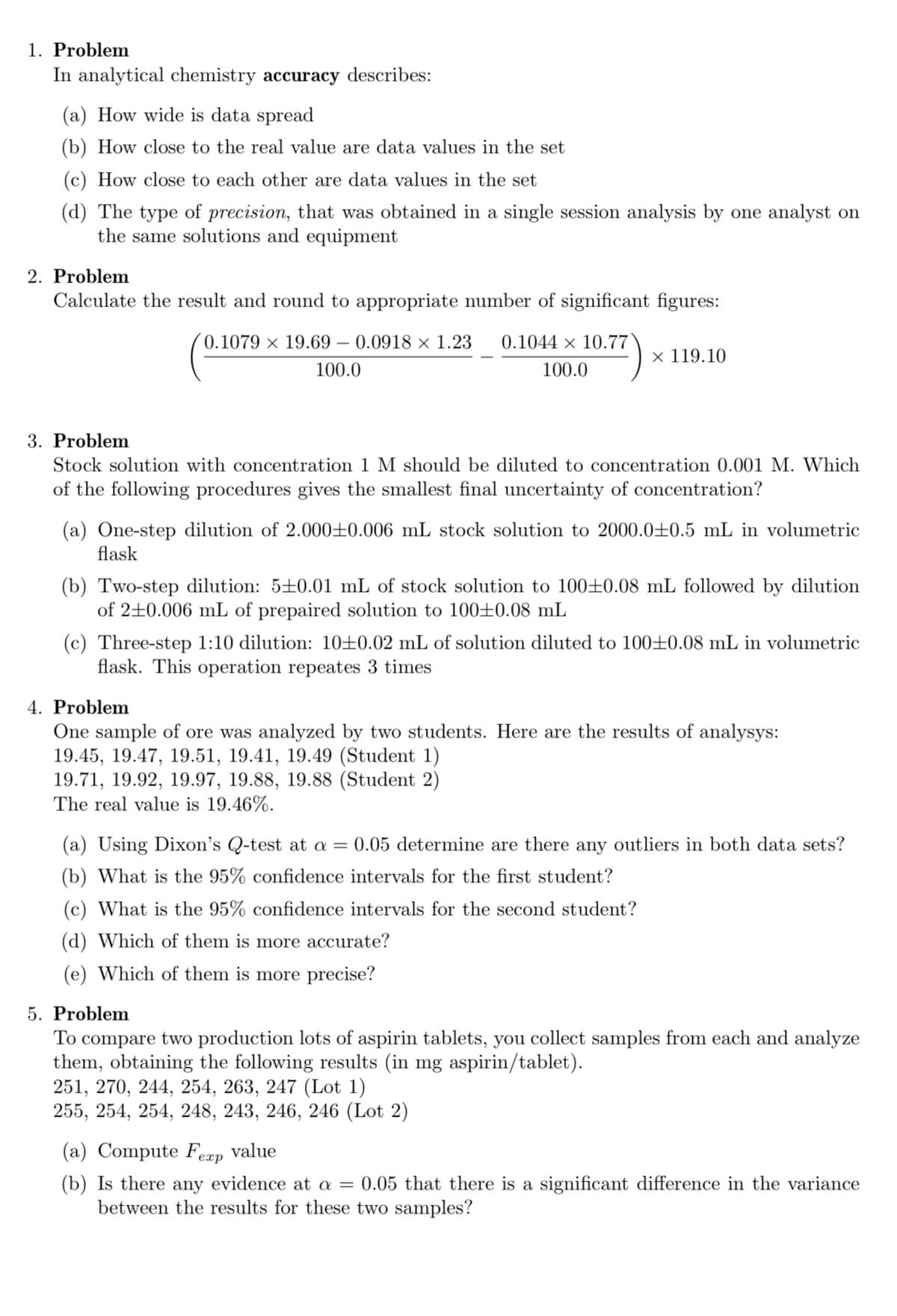1. Problem In analytical chemistry accuracy describes: (a) How wide is data spread (b) How close to the real value are data values in the set (c) How close to each other are data values in the set (d) The type of precision, that was obtained in a single session analysis by one analyst on the same solutions and equipment 2. Problem Calculate the result and round to appropriate number of significant figures: 0.1079 x 19.69 – 0.0918 x 1.23 0.1044 x 10.77 x 119.10 100.0 100.0
1. Problem In analytical chemistry accuracy describes: (a) How wide is data spread (b) How close to the real value are data values in the set (c) How close to each other are data values in the set (d) The type of precision, that was obtained in a single session analysis by one analyst on the same solutions and equipment 2. Problem Calculate the result and round to appropriate number of significant figures: 0.1079 x 19.69 – 0.0918 x 1.23 0.1044 x 10.77 x 119.10 100.0 100.0
Chapter7: Statistical Data Treatment And Evaluation
Section: Chapter Questions
Problem 7.11QAP
Related questions
Question

Transcribed Image Text:1. Problem
In analytical chemistry accuracy describes:
(a) How wide is data spread
(b) How close to the real value are data values in the set
(c) How close to each other are data values in the set
(d) The type of precision, that was obtained in a single session analysis by one analyst on
the same solutions and equipment
2. Problem
Calculate the result and round to appropriate number of significant figures:
0.1079 × 19.69 – 0.0918 × 1.23
0.1044 × 10.77
х 119.10
100.0
100.0
3. Problem
Stock solution with concentration 1 M should be diluted to concentration 0.001 M. Which
of the following procedures gives the smallest final uncertainty of concentration?
(a) One-step dilution of 2.000±0.006 mL stock solution to 2000.0+0.5 mL in volumetric
flask
(b) Two-step dilution: 5±0.01 mL of stock solution to 100±0.08 mL followed by dilution
of 2+0.006 mL of prepaired solution to 100±0.08 mL
(c) Three-step 1:10 dilution: 10±0.02 mL of solution diluted to 100±0.08 mL in volumetric
flask. This operation repeates 3 times
4. Problem
One sample of ore was analyzed by two students. Here are the results of analysys:
19.45, 19.47, 19.51, 19.41, 19.49 (Student 1)
19.71, 19.92, 19.97, 19.88, 19.88 (Student 2)
The real value is 19.46%.
(a) Using Dixon's Q-test at a = 0.05 determine are there any outliers in both data sets?
(b) What is the 95% confidence intervals for the first student?
(c) What is the 95% confidence intervals for the second student?
(d) Which of them is more accurate?
(e) Which of them is more precise?
5. Problem
compare two production lots of aspirin tablets, you collect samples from each and analyze
them, obtaining the following results (in mg aspirin/tablet).
251, 270, 244, 254, 263, 247 (Lot 1)
255, 254, 254, 248, 243, 246, 246 (Lot 2)
To
(a) Compute Feæp value
(b) Is there any evidence at a = 0.05 that there is a significant difference in the variance
between the results for these two samples?
Expert Solution
This question has been solved!
Explore an expertly crafted, step-by-step solution for a thorough understanding of key concepts.
Step by step
Solved in 4 steps with 4 images

Knowledge Booster
Learn more about
Need a deep-dive on the concept behind this application? Look no further. Learn more about this topic, chemistry and related others by exploring similar questions and additional content below.Recommended textbooks for you

